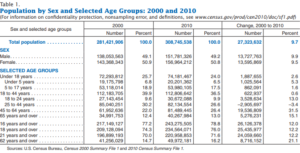The number of Americans ages 65 and older is projected to more than double from 46 million today to over 98 million by 2060, and the 65-and-older age group’s share of the total population will rise to nearly 24 percent from 15 percent.
The above is a quote from the “Population Reference Bureau.” Included in this increase in the elderly population is an a geometrically larger need for elder care.
What is driving this? Lets look at some data from the last two census periods:
The cause is partly the 15.1 percent rise in the 65 and over age group. It is partly the 21.1 percent rise in the 62 and over age group. The main driver though is the 31.5 percent rise in the population 45 to 64. I am in my late 50’s and over the course of the rest of my life there will be an ever-increasing need for elder care and services to support this shift.
The elder care need will embrace services including but not limited to:
Acute hospital care
Nursing home care
Home health care
Hospice Care
Adult day care
Assisted living facilities
So why am I advocating for assisted living facilities or “ALFs” as an investment opportunity? First let me steal a phrase used in the ALF industry. It is an opportunity to do well by doing good. Our elderly need and deserve clean well run homelike places to live when they are unable to take care of themselves. ALF owners tend to be driven to help our elderly population. I have met many wonderful people in this industry.
The ALF industry is, by and large, less regulated than the other healthcare providers listed above because government provides essentially none of the funding for ALFs. It is for the most part supported by self payment. That may change in the upcoming years as the elderly population grows, but Medicare and Medicaid state plans seem to have little interest in providing ALF services. Sadly, Federal and state regulators seem content with waiting for disaster and pushing the elderly needing help into nursing homes when they can no longer fend for themselves.
In addition to the public good, for ALF owners there is a generous return on investment or “ROI” in the form of regular income that vastly outperforms rental real estate. Let’s use a hypothetical example here in Florida. An investor buys a house in Palm Beach for $350,000. They hit the jack pot and get a steady renter paying $3,500 per month. They put $35,000 down on the property and have a loan of $315,000. They are a good credit risk and get a fixed rate loan at 3.75 percent. Here is what their return on investment or ROI looks like:
Monthly Income $3,500
Mortgage ,1200
Property taxes 800
Repairs 600
Income $ 900
What about an alternative and converting the same house to an ALF? This same 3 bedroom house can have 6 beds each renting out for $3,000 per month. Gross revenue for your investment is now $18,000 per month. You do have a significant increase in cost. Providing supervision, meals and laundry services will cost a good operator around $8,000 per month. Lets look at your ROI now:
Monthly Income $18,000
Overhead 8,000
Mortgage 1,200
Property taxes 800
Repairs 1,500
Income $ 7,500
The ALF investment is not for everyone. To get involved you need to become licensed and learn all the rules. Here in Florida you will have to provide a generator capable of keeping the lights and electricity on in the event of a natural disaster. For people willing to get involved in the ALF industry there is still an opportunity to do well by doing good.
Timothy Powell, CPA

